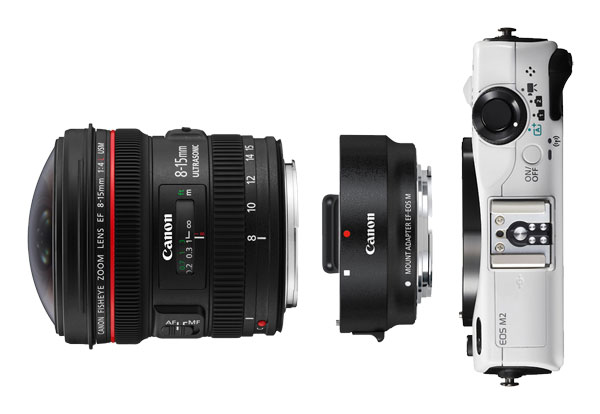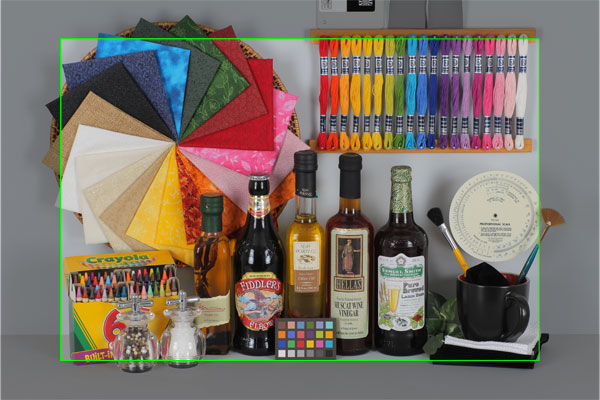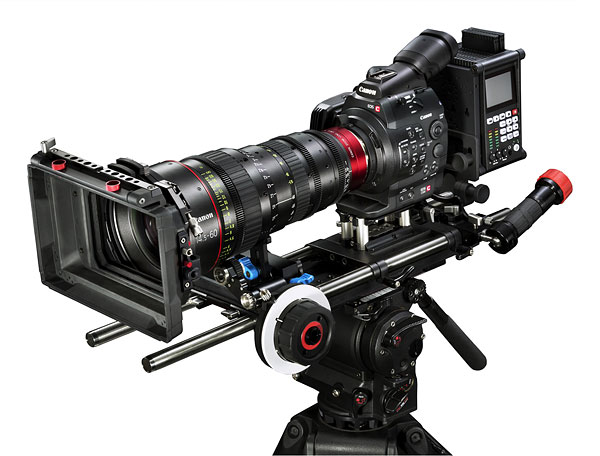Canon Q&A: The future of EOS mirrorless and the challenges of on-sensor AF
posted Thursday, February 27, 2014 at 8:03 PM EDT

Group Executive,
ICP Group 2,
Image Communications Products Operations,
Canon Inc.
During the CP+ photography tradeshow in Japan, Imaging Resource publisher and editor-in-chief Dave Etchells met for interviews with executives from some of the best-known brands in the camera business. Since the show ended somewhat prematurely due to extreme weather, Dave travelled around Japan for more meetings and tours of facilities around the country, and continued with the interviews en route.
Now that he's back on home turf, the mammoth task of transcribing all these great interviews is well and truly under way. To follow the Nikon interview published a fortnight ago, we have a two-parter with the company's long-time rival. Dave sat down with executives from Canon Inc. for a frank discussion about the company's EOS mirrorless plans, their groundbreaking Dual Pixel CMOS AF technology, the future of video capture in interchangeable-lens cameras, and plenty more besides.
Taking part in the interview were Tokyo-based Mr. Go Tokura, Group Executive, ICP Group 2, Image Communications Products Operations, Canon, Inc, and his colleague Mr Naoya Kaneda, Senior General Manager, ICP Development Center 1, Image Communications Products Operations, Canon, Inc., who's based out of the company's Optics R&D Center in Tochigi, Japan. Both gentlemen spoke through and interpreter, and subsequent to the interview, Dave followed up with further questions that were deftly fielded by Chuck Westfall, Advisor, Technical Information at Canon USA Inc. (You can find the information courtesy of Chuck, which focuses on Canon's Dual Pixel CMOS AF technology, in a separate news item.)
Without any further ado, let the interview commence!
Dave Etchells/Imaging Resource: What can you say about the future of the EOS M system? The original EOS M has been discontinued, and the EOS M2 didn't come to the U.S. at all. Will we eventually see the M2 in the U.S., or will you wait until the next generation? Or will there be a next generation?
Go Tokura/Canon Inc. (via translator): There are plans for the M2 to arrive in the U.S.
[Editor's note: We received an update after we went to press that Canon USA does not have plans to sell the EOS M2 at this time. We'll let you guys know if this changes!]
DE: Oh, good.
GT: However, having said that, I should make clear that that's the decision that is led by the sales groups in each division, so they are the ones who are holding the decision-making responsibility on that.

DE: I understand. We saw a great-looking EF-M 11-22mm f/4-5.6 IS STM super-wide zoom announced last summer, but that still leaves the EOS M system with only three lenses. We've seen a fairly broad range of lenses apparently intended for the EOS M system appear in patent filings, but there have been no public announcements as yet. Can you speak at all about a lens roadmap for the EOS M system? A firm roadmap would do a lot to assure our readers that Canon fully intends to support it going forward.
GT: I can assure you that we do have plans to roll out some lenses in the future. As far as speaking concretely about a roadmap, I'm afraid that based on our company policy, we can't make any concrete statements about that. When the time comes, we will make an announcement about that accordingly.

DE: I'm curious: Are you finding that the primary market for the EOS M is people who are already Canon EOS users, and that they're mainly interested in using their existing EF-mount lenses on it? (This describes the two members of the Imaging Resource team who bought the EOS M for their own personal use.)
GT: The consumers that are purchasing the EOS M are not always existing EOS users. A lot of the purchasers take to the fact that it's a compact-sized camera, and they'd like -- if at all possible -- to avoid the size and weight of DSLR cameras. The ones that place an emphasis on that, we found, are purchasing the M series. Of course, part of the benefit is that they can make use of EF lenses.

DE: The EOS M is a fantastic deal at the $300 price that it sold for in the U.S. over the holiday season, and at the $350 that it's selling for now. Our impression is that sales really picked up once that price change happened -- in fact, two of our own staff went out and bought one for themselves. Would a price point like that be sustainable for the EOS M going forward, as opposed to being just a clearance price?
GT: First, as far as background information, the price in local markets is also determined by the sales companies. That's not something that Canon Inc., the headquarters, is able to control -- just so you know, as background information. Another factor is the exchange rate; that fluctuates, and the exchange rate will have an impact on the price as well. We also take into account what our competitors are doing, and their pricing. In light of all those factors and those conditions, we try to find the most suitable price for our products.
DE: Initially, the EOS M's autofocus system was very slow, but a firmware update made a significant improvement. In our tests, it took about a half a second off the full autofocus cycle. Can you describe the nature of that change? What was done in the firmware to make that improvement?
GT: One of the factors that we placed a lot of emphasis on was that the autofocus should be able adapt to various types of subjects, and also would be operating optimally across a variety of different scenes or conditions. That's where we placed the strong emphasis. In the early version of the AF system, what we were trying to do was ensure that autofocus would operate even in very harsh conditions, in very unusual or difficult circumstances. We placed so much emphasis on it being able to adapt to those situations that it kind of hung in there more than we would have liked it to. [Apparently, it was taking a very slow, conservative approach to AF, taking pains it didn't need to when conditions were more favorable.] In very basic, simple scenes, it wasn't adapting as well as we would have liked.

DE: So it was a very conservative design, in other words.
GT: Yes. So, to improve it, we tried to place more emphasis on the ideal balance, and we also listened to what our users told us, and based on that information, we adjusted the balance so that it would be better adapted to basic scenes as well as sort of challenging environments.
DE: Even after the firmware update, the EOS M's autofocus times are still slow compared to off-chip systems, and also even to many contrast detection systems. This is also true of the 70D's on-chip phase detection, at about a half second for a full autofocus cycle. The 70D is noticeably faster than that of the EOS M, but still quite a bit slower than even consumer level phase detection systems using a separate sensor. What prospect is there for further increasing the AF speed in future sensor designs?
GT: As far as improving autofocus, that's a never-ending thing. That's something we will constantly be battling and working to improve. But also, there needs to be an adjustment with lenses in accordance with the AF as well. It's in these areas that we'll work to improve AF speed in the future. Through the firmware update, we were able to improve the autofocusing performance for the EOS M, but as far as the M2 goes, there were some changes made to the hardware -- on the hardware side of things -- so it's with changes like that as well that we're working to improve autofocusing speed.
DE: I see. This is a general question relative to on-chip phase detection: We've seen some fairly fast autofocus performance from other manufacturers with the on-chip phase detection, and have been told that that's because they use the the PDAF to fully determine the focus, whereas Canon uses PDAF to approximate, and then fine tunes with contrast detect. Is that the case, and if so, what are the obstacles or contrary reasons for letting the on-chip phase detection do all the work?
GT: The final question being..?
DE: The final question is, what are the reasons that cause you to switch to contrast detection, rather than letting phase detection do all the work?
GT: By letting the contrast AF handle the final phase of focusing, that enables a higher level of precision in focusing.
DE: So just using phase detection by itself perhaps wouldn't be sufficiently accurate?
GT: In most scenes, it will not prove as accurate to the degree of accuracy that we would like, which is why we hand it over to the contrast detection AF to ensure proper accuracy and precision. This also relates to the Dual Pixel CMOS AF that's incorporated in the 70D, and that uses contrast detection to ensure proper accuracy.
DE: Ah, I see. How did the extraordinary on-chip phase detection system in the 70D come about, the Dual Pixel CMOS AF? What were the challenges that had to be overcome to enable it?
GT: Dual Pixel CMOS AF ties in with the fabrication of the actual sensors themselves, and it required a higher level of precision in the fabrication of the sensors. That was a primary challenge that we had to overcome -- we had to be able to do that before we could realize the technology behind Dual Pixel CMOS AF.
DE: I see, so it was the precision of alignment between layers on the chip?
GT: It was miniaturization of the circuit patterns that are exposed on the chips themselves.
DE: Ah -- the minimum feature size?
GT: The minimum feature size, yes. There were also issues having to do with electric signal processing that needed to be taken care of as well; algorithms, etc. It's kind of hard to say it was just one challenge that had to be met, because there were so many aspects that needed to be addressed to realize this system. It wasn't just a single technological challenge.

DE: With Dual Pixel CMOS AF, is it the case that every pixel on this entire sensor can be read out in two halves? That's one half of a question; the other is, are the two halves combined together on-chip for image data readout, or are they read out, and then combined in a later stage of processing?
GT: Each pixel has two full readouts, so every pixel on the sensor can be read as two halves.
DE: So every pixel.
GT: That's the first question. And the second part...
DE: The second part was whether the signals from the two halves of each pixel are combined on the sensor chip for data image readout, or if they're read out separately and then later combined in the processor? Are the signals mixed or added on-chip, as opposed to...
GT: Unfortunately, when the photo diodes receive the light and how they send out the signals, we're not able to tell you.
DE: Oh, you can't talk about that. Okay.
GT: The light energy that is sent out from the photo diodes, they can be sent to the autofocus processing, and they can also be sent for image processing.
DE: They can go two directions.
GT: Yes, they can serve double roles.
DE: That actually answers my next question, which was that we had heard the dual pixels can be read out separately and together at the same time, like when recording video. I was wondering if I understood that correctly, or if it's a matter of having pixels on one row operate in AF mode, and the next row operate in full pixel image readout.
GT: In general, your understanding that they readout together at the same time is true, but actually, during the processing, where exactly they're combined is...
DE: Proprietary information.
GT: Yes, we can't really tell you exactly what happens with it.
DE: But generally, that's what happens.
GT: Yes, your understanding is correct.
DE: I'm curious, with every pixel on the array being available for phase detection, can or does the camera form autofocus points at arbitrary locations, depending on where it finds the subject? In other words, a traditional autofocus sensor has fixed points, but here, conceptually, any appropriately-positioned group of pixels can be made into an autofocus element. I'm wondering -- can the 70D put an AF point here, or here, or here (gesturing), wherever it wants to?
GT: Yes, it's possible that you could have an AF point anywhere you like.
DE: Does the camera actually do that?
GT: Yes.
DE: Ah, very good.
[This was a point I'd heard in our original briefing on the Canon 70D, but I wanted to confirm it because it's so significant. While it's not clear just to what extent the 70D dynamically forms AF points in response to subject detection and movement, the fact that it can and does at all is a pretty big deal.
The reason high-end AF systems have so many AF points is because the camera can only detect subject distance at those specific locations. As a consequence, accurate focus tracking needs a lot of points covering a large area of the frame, so subject distance and position can be handed off from one to the next, providing a more or less continuous history of its motion. With the 70D, though, the camera can theoretically create and move an AF point or group of AF points to precisely follow the subject as it moves across the frame.
While the speed of the on-chip PDAF system isn't (yet) high enough for sports-type still-photography applications, it's entirely adequate for video AF. On the other hand, the DFD (distance from defocus) technology just announced by Panasonic claims to give the GH4's AF system a similar ability to determine at least changes in subject distance anywhere in the frame]
GT: However, it's not for the entire imaging area -- it's for the 80% coverage for which phase detection is possible within that.

DE: Yes, and that has to do with the lens and the light paths. Can -- and does -- the camera use extremely long phase detection baselines at very large apertures to improve accuracy? Conventional phase detection f/5.6 is like this, but f/2.8 longer [gesturing to indicate a narrower baseline at f/5.6, but a wider one at f/2.8], but that's as far as it goes -- can Dual Pixel CMOS AF technology, at f/1.2, maybe go wider still?
[There followed a long and somewhat confusing section here, trying to communicate technical details across the language barrier. Unfortunately, I burned up quite a bit of the limited interview time with this, and ultimately ended up checking back with Chuck Westfall of Canon USA Inc. for clarification. Ultimately, that's where I should have started, given Chuck's deep technical understanding and ability to communicate with Canon Inc's technical people over time. Given that his response was so insightful, I've posted Chuck's answer as a separate article about Canon's Dual Pixel CMOS AF system.]
DE: What are the trade-offs associated with Dual Pixel CMOS AF? Is there any trade-off in terms of noise, perhaps because there's a smaller light-gathering area with the extra circuitry?
GT: We have yet to find any negatives or demerits.
DE: Does Dual Pixel CMOS AF technology increase manufacturing costs compared to a conventional sensor -- perhaps through lower yields? The point of my question is whether the cost structure of Dual Pixel CMOS AF is amenable to making its way down to consumer-level models.
GT: To tell the truth, it's quite expensive. Maybe that's one of the -- you asked about negatives -- that's a drawback. *laughs* However, of course, the more we make, the more the cost will come down. In that regard, we are looking to deploy it or to expand it into lower-model cameras.
DE: Over time, you'll drive the cost down.
GT: Compared to Dual Pixel CMOS AF, the Hybrid CMOS AF is cheaper. We have plans to use both of those sensors going forward.

DE: This is a little bit of a strategy question. DSLR video has been a huge strong point for Canon, a huge win. You've since developed the Cinema EOS system as an extension of that, but in the conventional interchangeable-lens market, other manufacturers are starting to challenge more, particularly Panasonic with their just-announced Lumix DMC-GH4. Obviously, Canon has the technical ability to address that, but I'm wondering , strategically -- is your main focus going to be on the more expensive Cinema EOS system to deliver those kinds of features? Or can we expect to see capabilities similar to the GH4 appear in the next generation of Canon DSLRs?
GT: It's not that we're only going in the direction of Cinema EOS.
DE: It's not an A or B kind of thing, you're saying?
GT: It's not black and white like that. Having said that, I would like you to understand that the video capture capabilities within DSLRs are a very important function that we will continue to focus on. Of course, video capture performance is going to be an important factor, and of course, the higher up the series that you go, you're going to find very high-performance video features. However, it will be necessary to bring those down to the middle level and entry level models as well, in the future.
DE: A question for Kaneda-san: It's no secret that ever-shrinking pixel sizes have put a lot of pressure on lens designers to develop sharper lenses. Is that the greatest challenge in lens development currently? If not, what is the greatest challenge?

Senior General Manager,
ICP Development Center 1,
Image Communications Products Operations,
Canon Inc.
Naoya Kaneda/Canon Inc. (via translator): That is an important challenge, an important thing that we need to overcome, but it's not the most important -- it's one of them. As pixel size -- the actual pixel dimensions -- get smaller, the more you close the aperture, the more you get image degradation. The challenge becomes that as pixel sizes get smaller, we have to create brighter lenses with better resolving power.
DE: Ah, yes. Better resolving at larger apertures.
[The point here is that the smaller pixels become, the lower the diffraction limit becomes as well. The diffraction limit is the point at which, as you stop down the lens, the image becomes less sharp due to optical diffraction effects. With larger pixels, the diffraction limit may not be reached until f/5.6 or f/8, whereas for very small pixels, diffraction could limit resolution beginning at f/4 or even lower. So as pixels become smaller, it's important that lenses can be at their sharpest at wider apertures than previously, in order to take full advantage of the resolution of the sensor.]
NK: For example, in the last few years, a couple of lenses that we've released -- the EF 24-70mm f/2.8L II USM and the EF 70-200mm f/2.8L IS II USM -- those are examples of lenses where we've tried to combine those two factors, to make them brighter and also have higher resolving power. At the beginning of my response to your question, I said that it's one important factor, but not the only important factor or challenge that needs to be overcome. Another is that, with the shift to digital photography, the number of pictures that users are taking has greatly increased, which puts demands on the durability of lenses. We need to make lenses that hold up better and are more rugged, in response to this increased use. Another is the growth of video capture; we need lenses that perform more smoothly [meaning in both focus and aperture adjustments], so they're not exclusively for still images anymore. So those are other equally important challenges.
DE: That's very interesting, I hadn't thought about that. Professional lenses have always needed to be rugged, but now consumers are taking so many pictures and using the lenses more, even consumer-level lenses need to be more durable. Very, very interesting. Well, I see that we're unfortunately out of time; thanks very much for making this time available to me, and for all the information you shared. I'm sure our readers will be very interested in all you've told me!
GT, NK: Thank you.